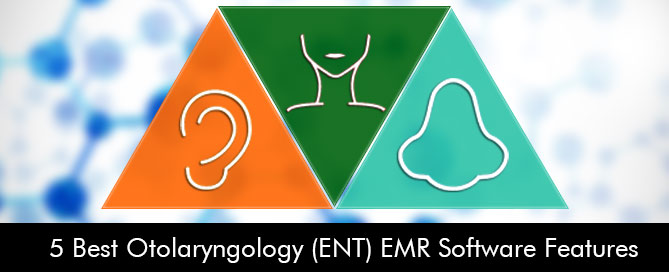The usefulness of an Electronic Medical Records (EMR) Software depends upon its optimal integration within the medical practice. Since each medical specialty practice has its own unique requirements which may often lie outside the parameters of the basic functionality of the EMR Software. Hence, the ability to customize the EMR Systems continues to be one of their most demanded features.
For Otolaryngology practices, the workflow and operations are considerably different from the other medical specialties, and hence require a certain kind of Electronic Health Records (EHR) and Practice Management Software to take care of all their tasks. There are hundreds of EHR Software available in the market, yet selecting the right Otolaryngology EMR Software for your clinic can be a challenge. Thus to make the selection process easier, here are some features that you need to look for in an ENT EMR System when considering it for purchase.
Dedicated Templates for Otolaryngology
EMR Software are hardly ‘one-size-fits-all’ in terms of specialty-specific templates for clinical use. The pre-designed templates for Otolaryngology cover a broad range of conditions such as allergy, snoring, thyroid, hearing loss, audiology assessment, etc. In addition to these templates being ENT-specific, they are also highly customizable and can be arranged and edited for multiple functions.
Customized Medical Coding
The built-in integration of otolaryngology-specific medical codes in the EHR System can help your healthcare clinic efficiently code Otolaryngology and ENT-related information for diagnosis and procedures. This information can be recorded into electronic “superbills” for fast and accurate coding and Medical Billing. The ENT software you go for must include E&M coding advisor by default. The E&M Coding advisor allows you to charge the appropriate level of service based on the services availed by the patient.
Audiology Exam
Audiology examinations are frequently performed in Otolaryngology and hence the best Otolaryngology EHR Software would provide the capability to connect with an Audiogram Software. This software allows audiology charts to be drawn easily. The exam findings such as the electrophysiologic tests or the emission measurements can also be preloaded for charting.
Multiple Device Integration
This feature is quite popular among EMR Software operating in all specialties and is equally useful in ENT specialty. Physicians rely on multiple devices including their office systems, personal computers, and mobile devices. The EMR System must allow remote access to all the data through mobile devices so that all patient records can be accessed, viewed, and edited even if the physicians are away from their clinics.
Patient Communications
Patient communication is a crucial part of the whole healthcare cycle. The more informed patients are, the more likely they are to participate in their own treatment procedures and hence get better results in terms of their health and recovery. Otolaryngology clinics frequently share print outs, wellness guidelines, and other documentation with the patients themselves. Rather than reinventing the wheel time and again, Otolaryngology EMR Software manages the access to documentation and other information and hence improves the communication between patients and their providers. A dedicated Patient Portal also proves helpful in this regard.








